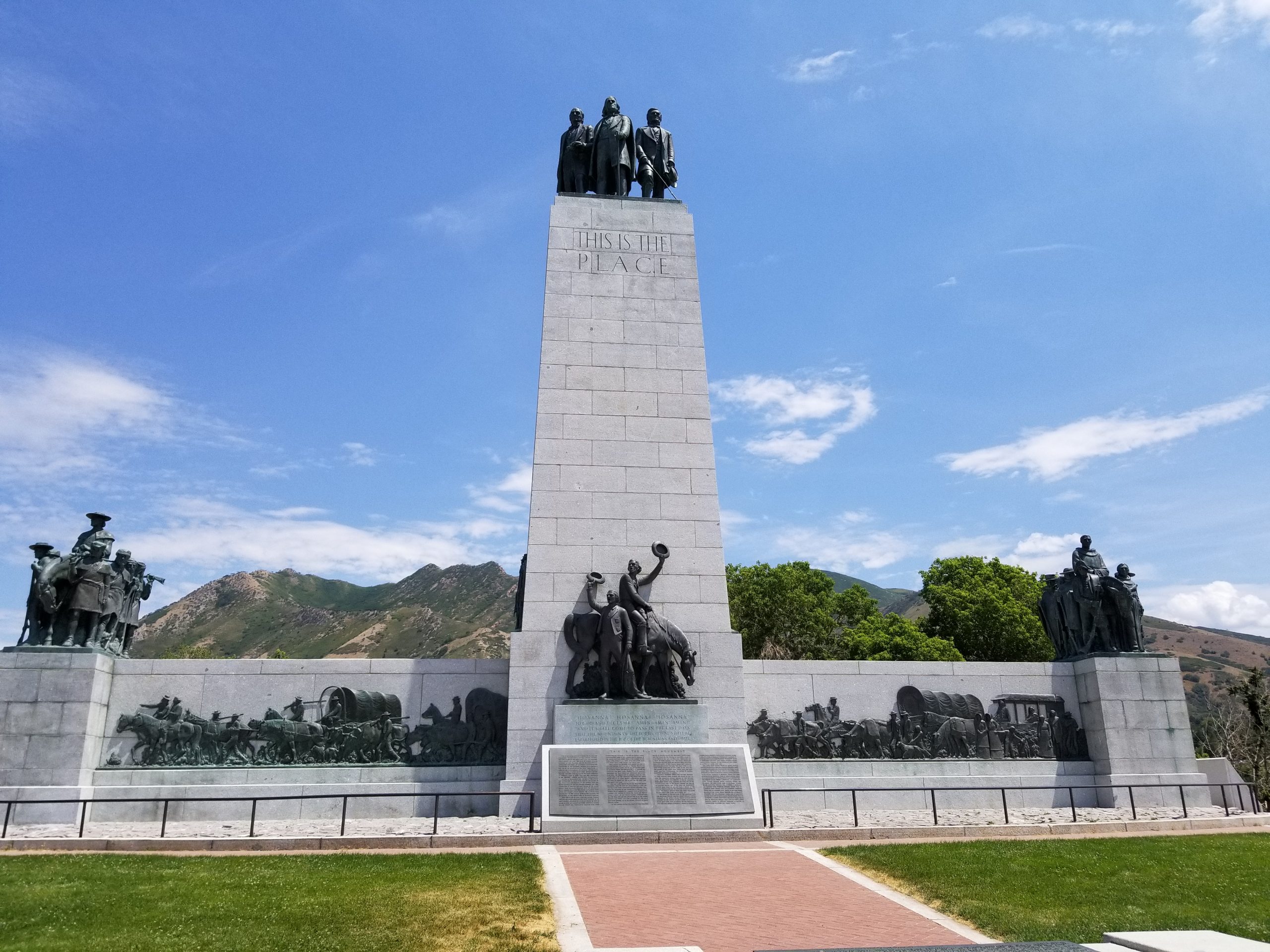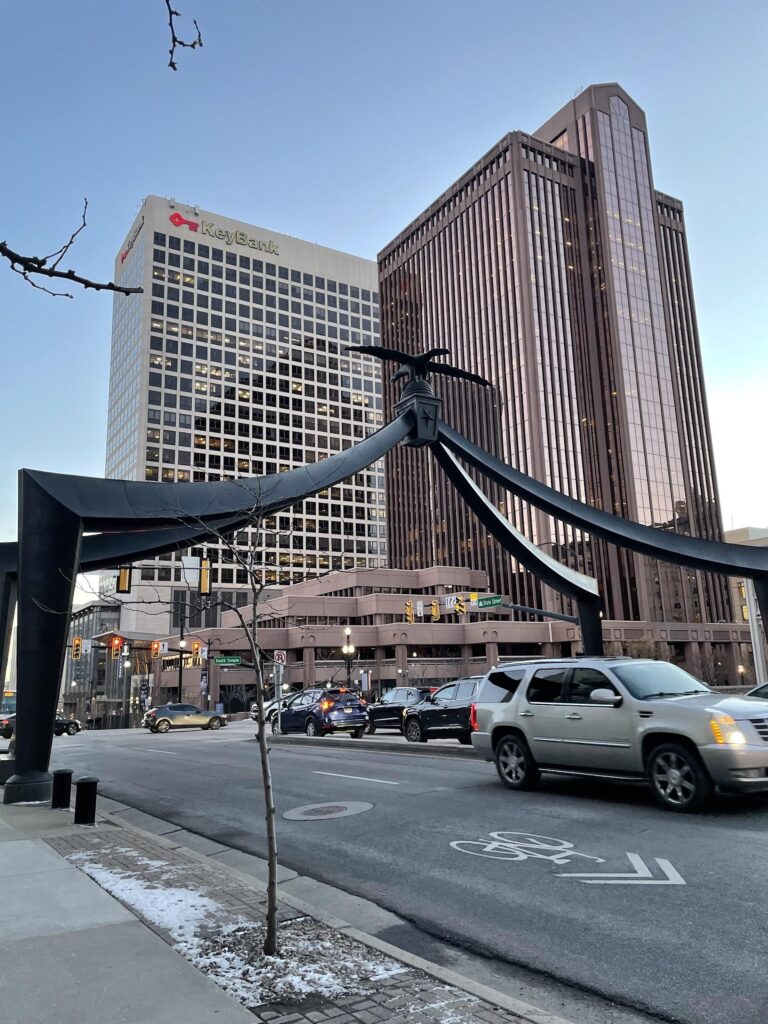Write-up by Brooklynn Jensen
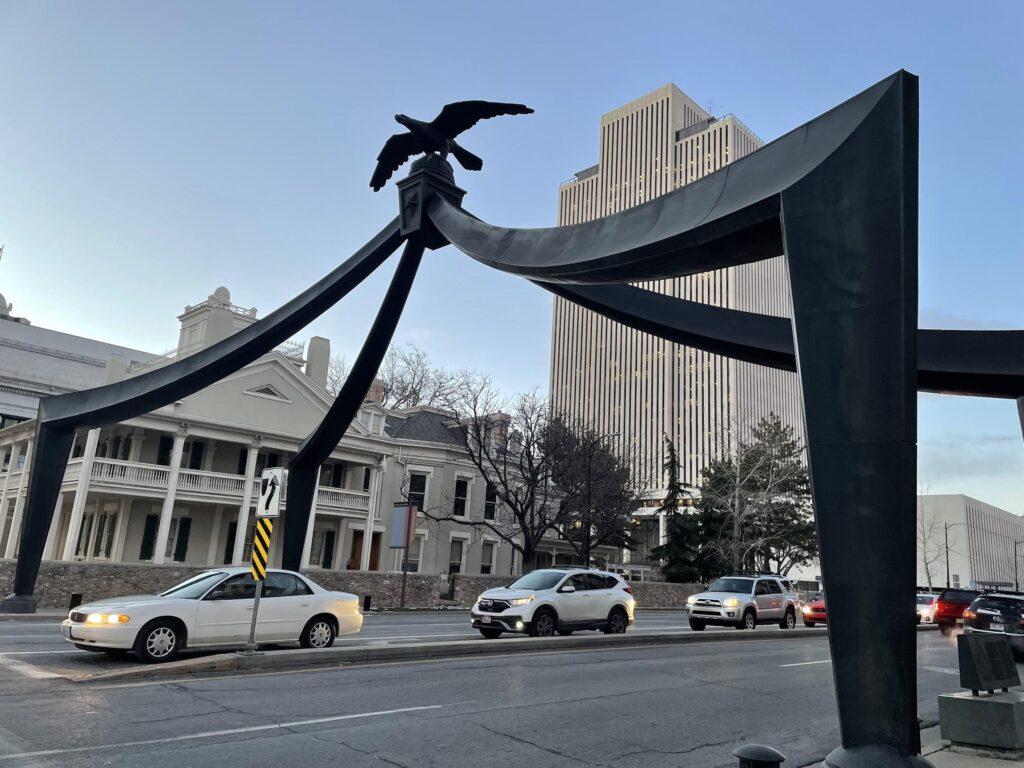
Placed by: The Church of Jesus Christ of Latter-day Saints, carved by Rolfe Ramsay in 1859.
GPS Coordinates: Latitude: 40.769577 Longitude: -111.888311
Historical Marker Text/Transcript (1):
Eagle Gate 1859
Truman O. Angell Architect
Hiram B. Clawson Designer
Rolfe Ramsay O William Bell Carver
1891
J. Don Carlos Young Architect
1963
Geo. Cannon Young P.A.I.A Architect
George S. Nelson Engineer
Grant R. Fairbanks Sculptor
Erected in Co-Operation With
The Church of Jesus Christ of Latter-day Saints
David O. McKay, President, & Utah State Department of Highways
O. Taylor Burton, Director
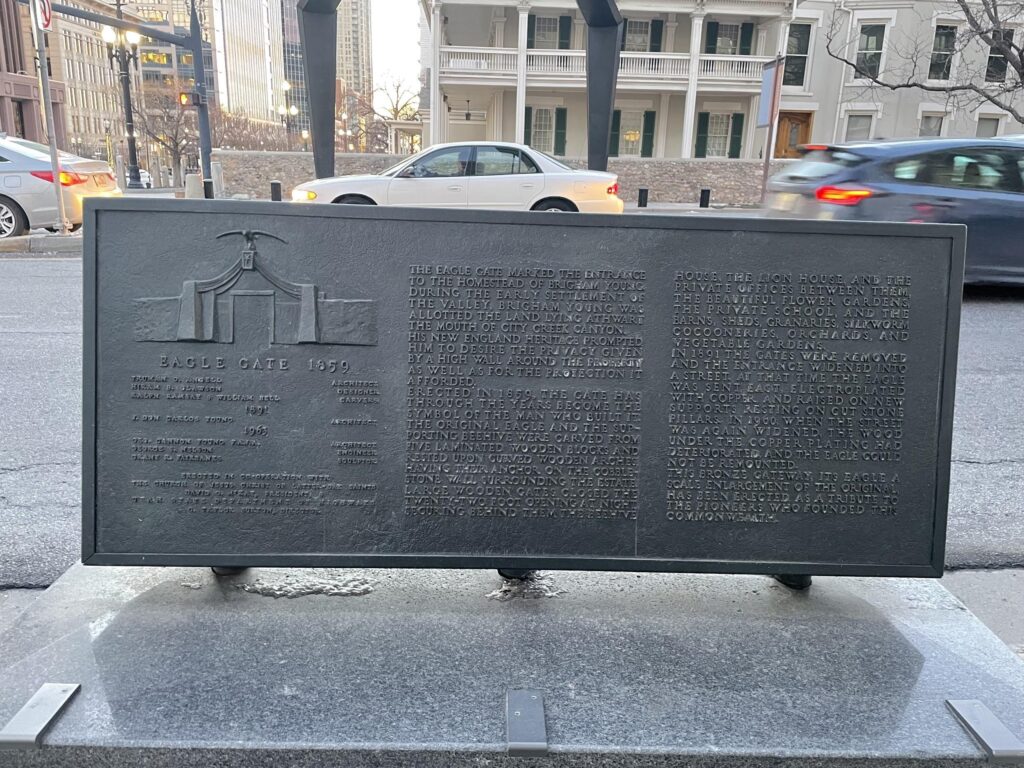
Historical Marker Text/Transcript (2):
“The Eagle Gate marked the entrance to the homestead of Brigham Young. During the Early Settlement of the valley, Brigham Young was allotted the land lying athwart the mouth of city creek canyon. His New England heritage prompted him to desire the privacy given by a high wall around the property as well as for the protection it afforded.
Erected in 1859, the gate has through the years become the symbol of the man who built it. The original eagle and the supporting beehive were carved from five laminated wooden blocks and rested upon curved wooden arches, having their anchor on the cobble-stone wall surrounding the estate. Large wooden gates closed the twenty-two foot opening at the night, securing behind them the Beehive House, the Lion House, and the private offices between them, the beautiful flower gardens, the private school, and the barns, sheds, granaries, silkworm cocooneries, orchards, and vegetable gardens.
In 1891 the gates were removed and the entrance widened into a street. At that time the eagle was sent east, electroplated with copper, and raised on new supports resting on cut stone pillars. In 1960, when the street was again widened, the wood under the copper plating had deteriorated, and the eagle could not be remounted.
This Bronze gateway, its eagle a scale enlargement of the original, has been erected as a tribute to the pioneers who founded this commonwealth.”
Extended Research:
Under the direction of Latter-day Saint President Brigham Young, the Eagle Gate was erected in 1859 in Salt Lake City. It was designed by Hiram B. Clawson and Truman O. Angell and carved by Ralph Ramsey. Originally, the eagle was made from wood, but later was reimagined and replaced with a sturdy bronze eagle in 1963. The original purpose of the Eagle Gate was to serve as a gate that kept out strangers and Native Americans from Brigham Young’s property and family.[1] It was accompanied by large wooden doors and quite literally was a gate, looking much different then than it does today.
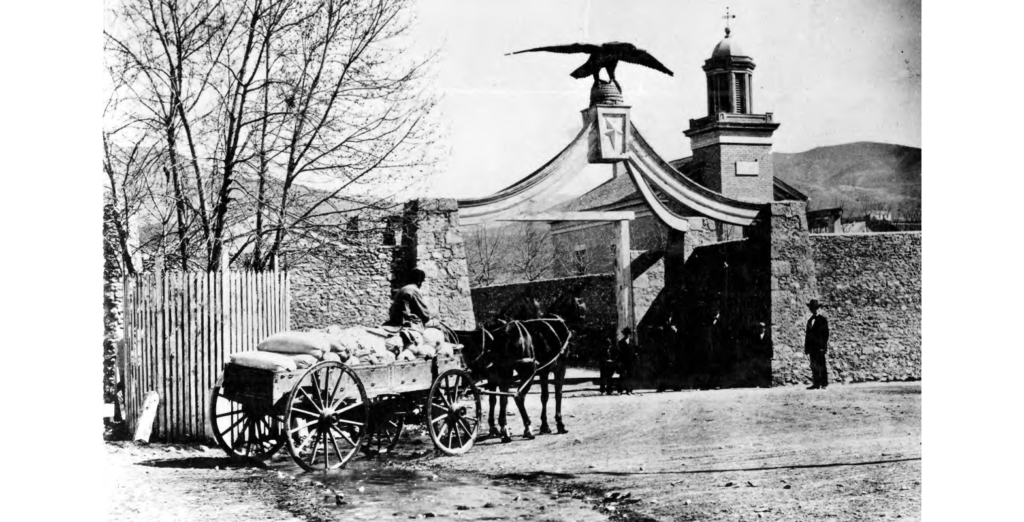
The original build of the Eagle Gate was connected to 8 foot high cobblestone walls and were originally only wide enough to allow for horse-drawn carriages and wagons. With time, the Eagle Gate underwent renovations for the sake of its preservation. It has gone through at least four alterations since its original creation.[2] Notably in 1891, improvements had to be made to allow for the Eagle Gate landmark to remain in the midst of the growing city. The eagle got a new perch with the iconic four piers and it also received a copper plating. Further adjustments were made for street cars and automobiles.[3]
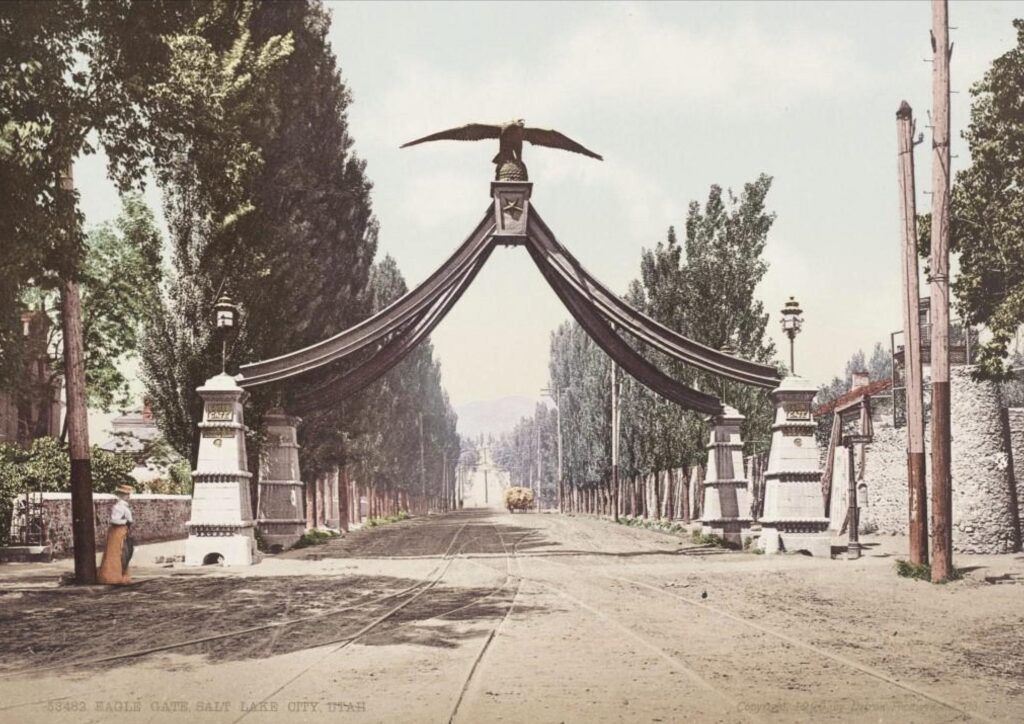
The Eagle Gate has been the center of discussions and debates since its erection, especially in the 20th century when Brigham Young and his posterity were not in a place of jurisdiction to answer questions or assume responsibilities. For example, an article from 1941 covers the debate over who the Eagle Gate belonged to. Did it belong to the LDS church or did it belong to the City?[6] One sure thing was that public opinion expressed that the Eagle Gate was and remains important and holds a great amount of significance for people, especially to Utahns who have roots to the pioneers who placed the monument. From 1936 before the monument underwent modifications, one woman said, “to change the gate would be to destroy the spirit of the monument.”[7]
The renovations made to Eagle Gate were sufficient until 1963, when the monument again had to be recreated to allow for a wider Main Street. This is when the eagle was fully replaced with its larger and bronze replica which is what we see atop the monument today. From 1859 at 22 feet in width to now 76 feet in width, the Eagle Gate has undergone changes and reformations in order to remain as an iconic landmark in downtown Salt Lake City.
Leaders of the Church of Jesus Christ of Latter-day Saints dedicated the current Eagle Gate monument as a symbolic reminder of the pioneer past. President David O. McKay, leader of the Latter-day Saints at the time, dedicated the monument on November 1, 1963, with these words: “May the new Eagle, with outspread wings perched on its new beehive, the old wall in its new trench, and every part of the new steel structure receive Thy divine approval and future protection.”[8] Today, Latter-day Saints look at the monument with reverie and remembrance of their pioneer ancestors and with inspiration towards the future.
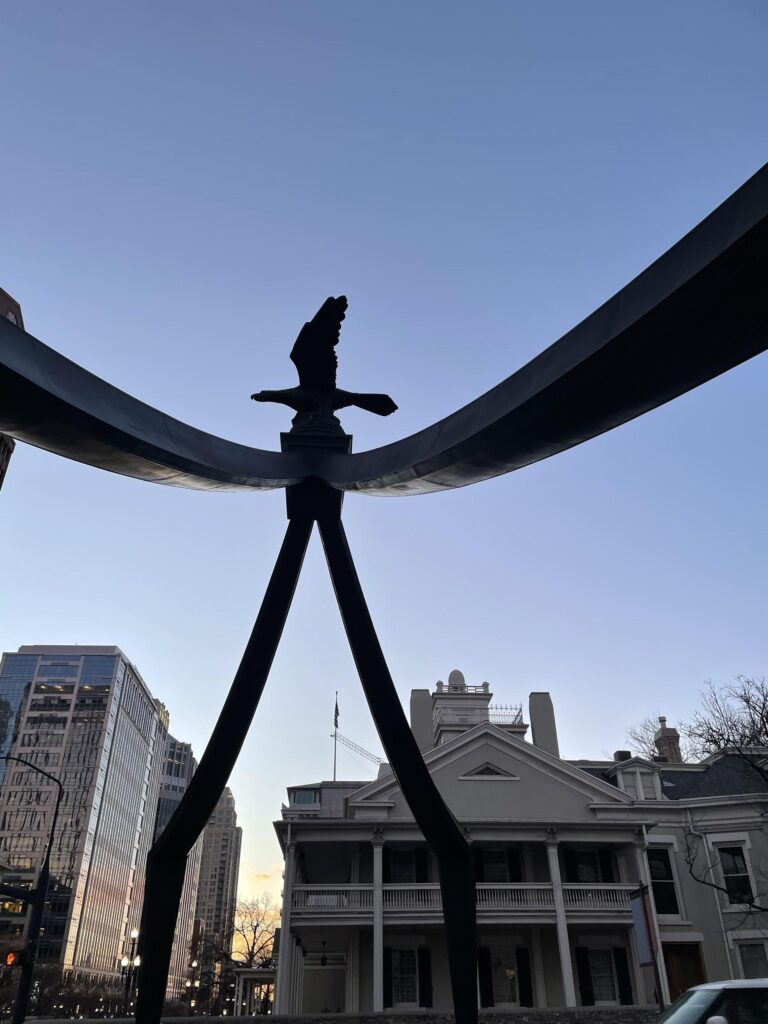
The original Eagle resides with the Daughters of Utah Pioneers in their museum.
[1] Irene M. Chen, “Historic S.L. Eagle grows and adapts to changing times,” Deseret News, February 26, 1970, https://collections.lib.utah.edu/ark:/87278/s6ns6kxr/1637701.
[2] Marc. Haddock, “Historic Eagle Gate a prominent Salt Lake Landmark,” Deseret News, September 18, 2015, https://collections.lib.utah.edu/ark:/87278/s6ns6kxr.
[3] “New Avenue Proposed to Save Eagle Gate,” Salt Lake Telegram, September 21, 1936.
[4] “Eagle Gate” https://collections.lib.utah.edu/ark:/87278/s6rr2c07.
[5] William Henry Jackson. Eagle Gate, Salt Lake City, Utah. n.d. Images, Overall, Primary Support: 6 3/4 x 9 1/16 in. (17.2 x 23 cm); Image: 6 3/4 x 9 1/16 in. (17.2 x 23 cm). Center for Creative Photography, University of Arizona;Gift of Terry Etherton. https://jstor.org/stable/community.17451366.
[6] “Who owns the Eagle Gate Monument? City Asks in Decorating Case,” Salt Lake Telegram, July 15, 1941.
[7] “New Avenue Proposed to Save Eagle Gate,” Salt Lake Telegram, September 21, 1936.
[8] Marc. Haddock, “Historic Eagle Gate a prominent Salt Lake Landmark,” Deseret News, September 18, 2015, https://collections.lib.utah.edu/ark:/87278/s6ns6kxr.
For Further Reference:
Sources
“Brigham Young’s Burial,” n.d., 1. https://jstor.org/stable/community.31325810.
“Eagle gate, Bransford Apartments, Eagle Gate Apartments and Louise Apartments,” November 11, 1914. https://collections.lib.utah.edu/ark:/87278/s61j9nxq
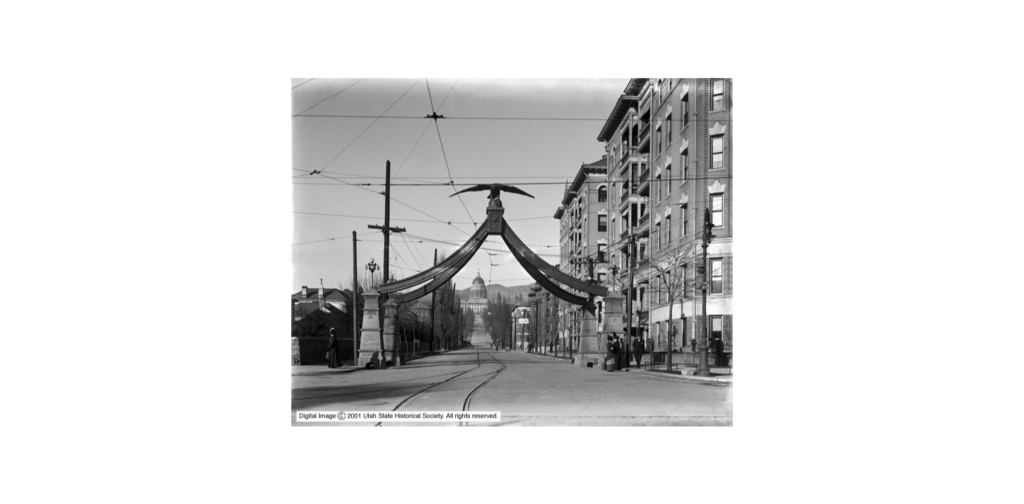
University of Arizona; Gift of Terry Etherton. https://jstor.org/stable/community.17451366
“New Avenue Proposed to Save Eagle Gate,” Salt Lake Telegram, September 21, 1936.
“Who owns the Eagle Gate Monument? City Asks in Decorating Case,” Salt Lake Telegram, July 15, 1941.
William Henry Jackson. Eagle Gate, Salt Lake City, Utah. Images, n.d.
Irene M. Chen, “Historic S.L. Eagle grows and adapts to changing times,” Deseret News, February 26, 1970.
Marc. Haddock, “Historic Eagle Gate a prominent Salt Lake Landmark,” Deseret News, September 18, 2015.
“Eagle Gate has seen many changes,” Deseret News, January 9, 2002.
“Eagle Gate,” This is the Place, Heritage Village.
“Eagle Gate Monument,” MormonWiki.com.
